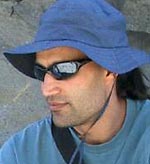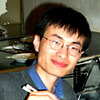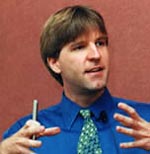Four young scientists lauded by national magazines
BERKELEY – Four young University of California, Berkeley, scientists have already reached the peak of their careers, at least according to two magazines that recently published lists of the world's top innovators in science and technology.
Three UC Berkeley scientists were named this week to the 2003 list of the world's 100 Top Young Innovators by Technology Review magazine, published by the Massachusetts Institute of Technology (MIT). Peidong Yang, ChevronTexaco assistant professor of chemistry; Jay T. Groves, assistant professor of chemistry; and Jason Hill, a recent PhD graduate of the Department of Electrical Engineering and Computer Science, were among 100 individuals "under age 35 whose innovative work in technology has a profound impact on today's world," according to the publication.
 Michael Manga |
Michael Manga, a UC Berkeley associate professor of earth and planetary science, was part of an even more elite group - one of the "Brilliant 10" announced in the September issue of Popular Science magazine.
Technology Review says its second annual list is meant to recognize young scientists "for their contributions in transforming the nature of technology in industries such as biotechnology, computing, energy, medicine, manufacturing, nanotechnology, telecommunications and transportation." Many of them will be honored Sept. 24 and 25 at The Emerging Technologies Conference at MIT.
Yang, whose expertise is the nanotechnology of nanowires, plans to attend the conference in Cambridge, Mass., to participate in a panel on nanotechnology.
"It's good recognition for the university as well as for our four years of work on nanowires at UC Berkeley," he said.
Groves, who will be unable to attend the conference, is modest about the honor. After all, two of his and Yang's colleagues in the College of Chemistry, Jeffrey Long and David Schaffer, received the same honor in 2002. But he does acknowledge the value of such awards to his field and to the university.
"I'm always trying to tell people what we do," said Groves, who studies cell membranes using biophotonic technologies. "So when this happens, it's good for the field of biophotonics, and it's good for UC Berkeley."
Manga tried to keep his win quiet, as did Groves, but word eventually spread through the department, and he now lists the honor along with others on his campus Web pages. He says his colleagues have been good sports about it and not ribbed him too much. He was pleased by Popular Science's brief account of his research, which he admits spans a broad range - practically anything having to do with fluids and geology. The magazine's photo, however, was enigmatic. Though not captioned, it showed him standing under the keystone of a grass-covered archway, the site of one of the springs he studies to determine the connection between spring flow and earthquakes.
Here is some brief background on the award recipients:
 Peidong Yang |
Peidong Yang, 32, is a leader in the creation of nanowires - minuscule wires a hundred thousandth the size of a hair - that he has shown can be grown from various materials to make a range of devices, from lasers to sensitive chemical detectors. Last year, he successfully mated nanowires of different materials to create one-dimensional junctions akin to transistor junctions.
Yang thinks nanowires are ideal for integrating nanoscale optoelectronics with large-scale devices. He is a founding member of the advisory board for the company Nanosys, Inc., which develops applications involving not only nanowires but nanodots and nanorods. Yang, who also is a faculty scientist at Lawrence Berkeley National Laboratory, has been at UC Berkeley since 1999.
 Jay Groves |
Jay Groves, 32, uses a variety of new chip-based strategies to dissect the function of living and reconstituted cell membranes down to the molecular level. These include electron-beam fabricated nanostructures, used to cage and guide the motions of proteins within living immune cells, and scanning-probe patterned membranes that mimic live cell membrane assemblies, but on a chip. Membranes exist throughout the cell and are far more than an outer shell that holds things in, he said. In fact, a majority of prescription drugs target cell membranes, making this molecular material extremely important to the pharmaceutical industry.
Several years ago Groves invented a way to corral membrane molecules on a silicon chip for study. He patented the MembraneChip and founded a company, now called Synamem Corp., that licensed this original technology to look for new drugs that suppress the body's immune response or fight infection. More recently, at UC Berkeley, he has integrated this basic technology with living cells for the first time. A new patent has been filed and a major current effort of the Groves group focuses on development of the living-nonliving interface, based on integrated membrane technology.
Groves, who also is a faculty scientist at Lawrence Berkeley National Laboratory, is a principal investigator with the Center for Biophotonics Science and Technology, a multi-university research center. The center, established last year at UC Davis with $40 million over 10 years from the National Science Foundation, accelerates the application of state-of-the-art optical tools to biology and medicine. He joined the chemistry department faculty in 2001.
 Jason Hill |
Jason Hill, 26, received his PhD last May from UC Berkeley, where he worked with the team that created the concept of "smart dust" - tiny sensors that communicate via a low-energy wireless network. They can be produced so cheaply that they can be scattered throughout buildings and are small enough to be attached to a bird. Earlier this year, he achieved a milestone by integrating sensors and a tiny computer operating system, called TinyOS, onto a chip barely bigger than a fleck of glitter. Called Spec, the new wireless mote integrates radio frequency communication onto a sensor processing chip, and measures a mere 5 square millimeters.
TinyOS allows sensors to relay information through their network neighbors so that the network will survive even if some of the sensors fail or are knocked out. The free software is now used by 80-some companies in sensors used for everything from energy monitoring in buildings to military surveillance.
Last year, Hill cofounded Dust, Inc., in Berkeley to build custom network applications, and this summer, he left UC Berkeley to form his own company, JLH Labs, in Capistrano Beach, Calif.
Michael Manga, 35, studies the evolution of planets, often creating models of planetary interiors to understand how million-year geologic processes work. His models range from cooler-size tanks of oil to 350-gallon vats of corn syrup, which enable him to study how hot rock moves from the center of the Earth to the surface, initiating volcanic eruptions. These models have already shed light on the causes of the world's volcanic hot spots and cleared up confusion about whether rising rock in the interior triggers explosive volcanic eruptions. He's also modeling the interiors of other planets, including Mars and Venus, but admits that his interests extend to anything dealing with fluids and geology, including the role spring water plays in triggering earthquakes. This is Manga's third year at UC Berkeley.

